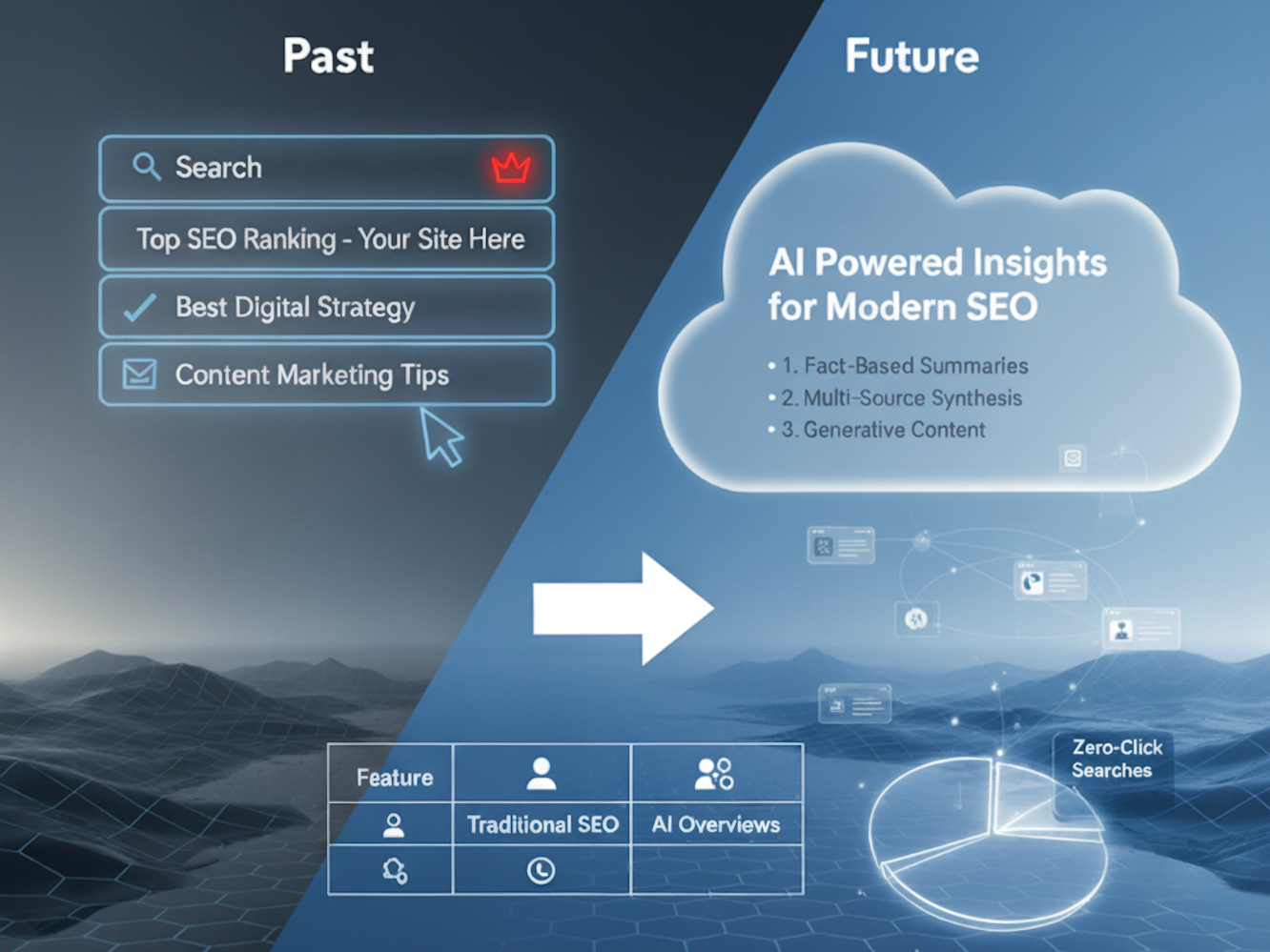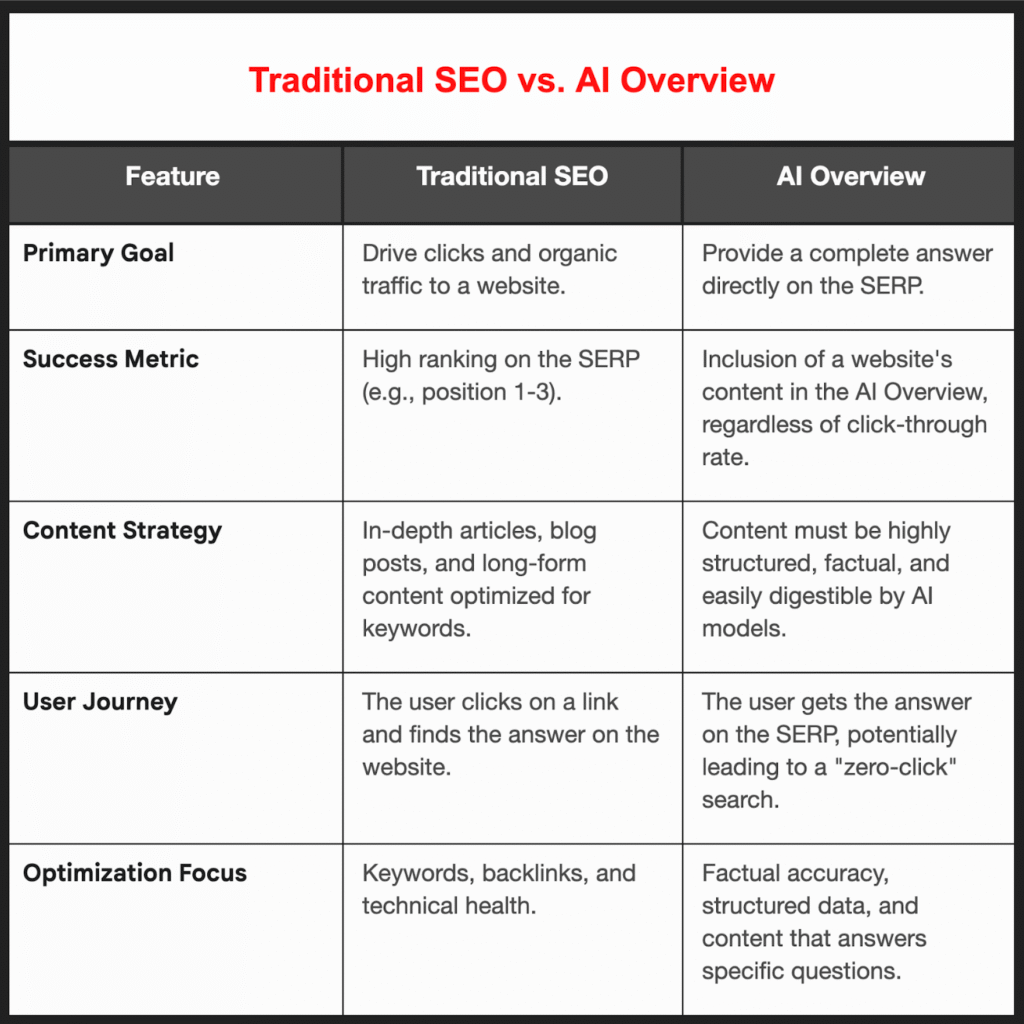|
Getting your Trinity Audio player ready... |
Charting New Territory with Google Search
A Direct Comparison Between Google SEO and AI Overview

Google’s search map has transformed. The familiar territory of ‘10 blue links‘ is giving way to a new horizon. For years, the primary goal of Search Engine Optimization (SEO) has been to rank at the very top of Google’s search results page. Now, AI Overview is surpassing those traditional results, fundamentally changing how we find information online. AI isn’t just influencing search—it’s becoming a seamless part of the search results themselves.
As the search landscape changes, this article provides a comprehensive comparison of Google SEO and AI Overview to help you adapt your strategies. It includes key statistics and insights to show how content creators must adapt as the search environment evolves.
What is Google SEO?
The Foundational Principles
At its core, SEO is a practice of optimizing websites to improve the ranking in traditional search engine results pages (SERPs). The goal is to signal to Google’s algorithms—such as the PageRank and RankBrain—that your website is the most relevant and authoritative source for a user’s query.
Key Components of Traditional SEO:
- Keyword Optimization: Using targeted keywords in content, meta descriptions, and titles to match user queries.
- Technical SEO: Ensuring a website is technically sound, with fast loading speeds, mobile-friendliness, and a clear site structure that is easily accessible to crawlers.
- Content Quality: Creating high-quality, in-depth, and well-structured content that provides genuine value to the user.
- Backlink Building: Acquiring links from other authoritative websites, which signals to Google that your site is a trusted source.
- User Experience (UX): Designing a user-friendly site that is easy to navigate and provides a positive experience.
The success of traditional SEO is measured by a website’s position in the SERPs and its ability to drive organic traffic through clicks.
What is Google’s AI Overview?
While traditional SEO measures success in clicks, the rise of Google’s AI Overviews is changing the equation. Google’s latest evolution is AI-generated search results, often referred to as AI Overview, also known as Search Generative Experience (SGE). Instead of simply listing links, Google’s AI models analyze vast amounts of data to provide a single, synthesized, conversational answer directly on the search results page.
This new form of search is powered by large language models (LLMs) such as Google’s Gemini. The AI doesn’t just display a summary; it generates a new response by “remixing” insights from multiple sources.
Key Characteristics of AI Overview:
- Direct Answers: The user gets a comprehensive answer without having to click on any links.
- Summarization: The AI pulls key points from various sources to create a new, concise summary.
- Source Attribution (with a caveat): While AI Overviews will often cite sources, they do not necessarily display the exact content as written.
- Generative Engine Optimization (GEO): This is a new and evolving field that focuses on optimizing content to enable easy processing and utilization by AI models.

The Impact: Statistics and the Shifting Landscape
The introduction of SGE is not a minor change; it’s fundamentally altering how users interact with search.
- Increased AI Presence: According to a Semrush study, AI Overviews were triggered for 13.14% of all queries in March 2025, up from just 6.49% in January of the same year. This indicates a rapid and sustained increase in the number of cases.
- Rise of the Zero-Click Search: Studies from WordStream and other sources show that AI Overviews are contributing to the trend of “zero-click” searches, where users find their answer on the SERP without clicking on any website. Some data suggests that AI Overviews could reduce clicks by nearly 35%.
- Content Sourcing: A notable statistic is that 40% of sources shown in AI Overviews would have otherwise ranked in spots 11-20 on the SERP, rather than in the top 10. This creates a new opportunity for quality content that may not have been able to compete with high-authority sites in the past.
- New Visibility: While clicks may be down for some, visibility can be up. Your brand may be mentioned in an AI Overview, which can increase brand awareness even without driving a click. This is a crucial distinction between traditional and AI-driven success.
New Visibility:
While clicks may be down for some, visibility can be up. Your brand may be mentioned in an AI Overview, which can increase brand awareness even without driving a click. This is a crucial distinction between traditional and AI-driven success.
The Future: SEO and GEO Working Together
The narrative that AI will “replace SEO” is premature at this time. Instead of being replaced, traditional SEO continues to evolve. The best practices of creating high-quality, well-structured, and authoritative content are more important than ever.
The future of search is a hybrid model where SEO and GEO (Generative Engine Optimization) work in tandem. To succeed, content creators and businesses must:
- Maintain Strong SEO Fundamentals: Continue to focus on technical SEO, site authority, and a positive user experience.
- Optimize for Generative AI: Create content that is scannable, factual, and directly answers questions. Use headings, bullet points, and Q&A formats that AI models can easily parse.
- Embrace the “Zero-Click” Reality: Measure success not just in clicks, but in brand mentions and inclusion in AI Overviews, which can lead to increased brand trust and authority.
The new Google search landscape presents both a challenge and an incredible learning opportunity. By understanding the core differences between traditional SEO and AI Overview results, you can ensure your content remains a primary source in this next chapter of the AI-powered web. It’s time to navigate this new horizon, not just for survival, but for growth.
